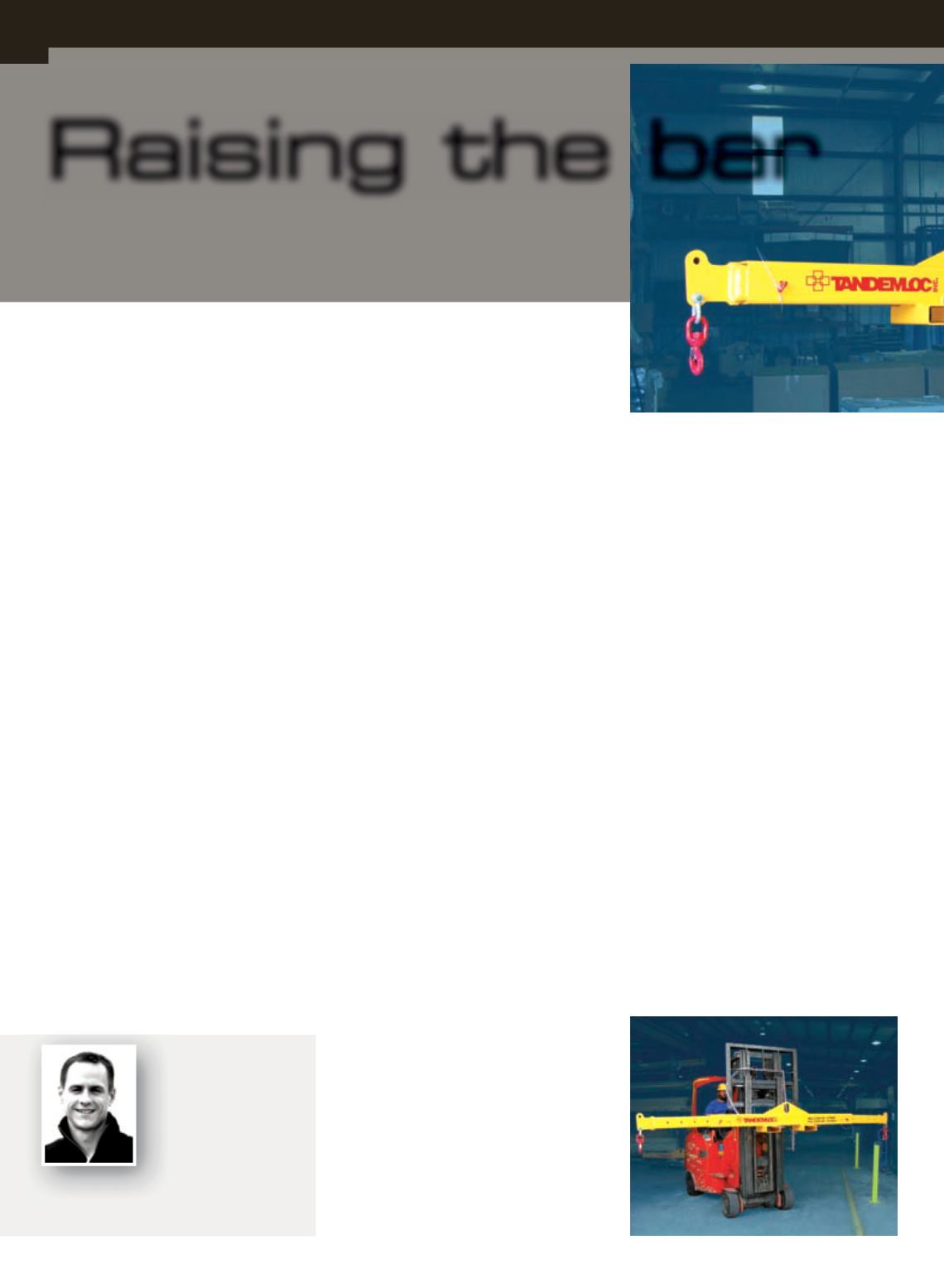
30
RIGGING REVIEW
ACT
DECEMBER 2013
Tim Hillegonds
reviews important safety issues regarding
below-the-hook lifting devices such as spreader bars.
THE
AUTHOR
Tim Hillegonds
spent
10 years in the heavy
construction insurance
industry before founding
Thrive Creative Services,
a creative copywriting agency dedicated to
helping businesses tell their stories.
I
t might be easy to look at the rigging
gear stacked up inside a crane
company’s shop and potentially
overlook the risks associated with below-
the-hook lifting devices. After all, there
are employees to manage and job safety
requirements to meet, as well as insurance
certificates that need to be requested.
Even when unintended, companies can
compromise on safety issues pertaining to
lifting devices such as spreader bars.
ASME B30.20-2010, the standard for
below-the-hook lifting devices, defines a
below-the-hook lifting device as “a device
used for attaching loads to a hoist. The
device may contain components such as
slings, hooks, and rigging hardware…”
The spreader bar, a frequently used
below-the-hook lifting device, is
commonly utilized when it’s necessary
to protect a load from rigging materials
and enable multiple pick points that
ensure a certain sling angle is maintained
throughout the hoist. According to Sam
Meyer, vice president, Marco Crane &
Rigging Co., Phoenix, AZ, they are an
essential piece of lifting equipment.
“A large portion of our work requires
some type of spreader bar,” said Meyer.
“I would estimate over 60 percent of our
jobs require one.”
Critical lifting gear
Spreader bars have long been a critical
piece of lifting equipment. Bill Smith,
former crane operator and executive vice
president of risk mitigation for NBIS, a
heavy equipment program underwriter
Meyer’s point is well taken. There’s a
certain level of inspection and knowledge
that’s required to be able to properly
use and select spreader bars. And since
spreader bars play an important role
in many of today’s lifts, the National
Commission for the Certification
of Crane Operators (NCCCO), an
organization dedicated to improving
performance standards through the
independent assessment of knowledge,
has developed a certification program
that tests a candidate’s level of proficiency
relating to spreader bars. These
certifications are obtained by passing the
Rigger Level 1 and Rigger Level 2 exams.
“[Using spreader bars] is a common
crane and rigging practice, and the
committee felt it was important to test
that knowledge set,” said Joel Olivia,
manager, program development and
administration for NCCCO. “The
NCCCO rigger exams cover a broad
scope of rigging activities, including
the identification, selection, inspection
and execution of rigging, while using
safe rigging practices and applications
throughout. Each of these areas is applied
to spreader bars, along with slings,
hardware and other rigging devices.”
When it comes to testing, Tandemloc,
based in Atlanta, GA, spends a great deal
of time walking through crane yards on
audits and still sees spreader bar practices
that make him grimace.
“There are times where we see old
steel piping and I-beams that have been
welded for one particular job or one-time
use,” Smith said. “They might be a quick
fix, but the problem is that they aren’t
properly engineered, welded, rated or load
tested. I saw it in the 1970s and I still see it
now. Companies that do that are looking
for trouble.”
What Smith means is that spreader
bars – just like slings, hooks and booms
– need to adhere to certain standards,
both during the manufacturing process
and when they’re being used. According
to B30-20-1.2.2 Construction (10)
“The manufacturer shall verify that
structural and mechanical lifting devices
are designed by or under the direct
supervision of a qualified person. The
design shall be in accordance with ASME
BTH-1 and shall consider the stresses
resulting from the application of rated
load plus the weight of the lifting device.”
When pipes, I-beams, or any other
material that’s just lying around the
crane yard is welded on and turned
into a spreader bar, there’s a significant
amount of risk that’s being created. These
temporary solutions – which certainly
don’t adhere to the recommended
standards and load-testing requirements –
are a proverbial crapshoot. The dice might
roll in your favor once, but the next time
could be a disaster.
“Spreader bars should always be
purchased or manufactured with
engineering behind it to meet current
OSHA safety factors, which are three
to one for yield,” says Meyer. “The bar
should be clearly labeled with the weight
of the bar, length and safe working load.
They should also be inspected prior to use
for any damage.”
Raising the bar
Tandemloc conducts an average of 3,521
tests a year on its below-the-hook products.


